Ernest William Bullock (1893-1978)
Introduction
In his retirement, my maternal grandfather, Ernest William Bullock, decided to write down his memoirs, producing over 50,000 words on his typewriter. Many of his stories are about his adventures in the Royal Navy, which he joined as a stoker in 1911. He saw plenty of action in World War One and his tales give you a real sense of life as a sailor in the early 20th century. However, for now, I want to share his account of his childhood with you.
Ernest was born on January 26th 1893, in Swindon, Wiltshire. When a small child, his family moved to the pretty market town of Marlborough in North Wiltshire, where his father was employed as a signalman on the railway. The setting for this account is therefore the late Victorian period of the 1890s. The quotes are all his own words. However, I have decided to add to his story by researching some of the places and topics that he mentions, including pictures where appropriate. Obviously, the resources I have used were not available to him when he wrote his memoirs, back in the 1970s. Over to you Granddad:
My earliest recollections are of the terrace in which our family lived at Marlborough in Wiltshire, having moved from the district of Rushy Platt in the neighbouring town of Swindon. We lived at No.11 Kingsbury Terrace:

A row of listed Georgian cottages off Kingsbury Street
Image –https://www.leaderlive.co.uk/homes/homes_to_let/in/Marlborough%2C+Wiltshire/gallery/14920992/

Kingsbury Terrace is marked, just off Kingsbury Street
This small cottage must have been a squeeze, with only two rooms upstairs for a family with five children all aged 12 and under.
At No.10 was a family named Monday, and at No.12 an older couple named Henry & Phoebe Waite who were childless. The husband there was a lamplighter and I clearly remember trotting alongside him when he lit or doused the lamps.
A search of the 1901 census reveals that George Munday, a bricklayer’s labourer is indeed living with his large family at 10 Kingsbury Terrace and Henry Waite, a lamp lighter, is at 12 Kingsbury Terrace. A boarder is lodging with him but his wife, Phoebe, is elsewhere. The Bullock family had moved from Marlborough by this time:

RG13 1925 8 8 National Archives (U.K) via http//:www.ancestry.com
Gas lighting was the most popular form of lighting, both indoor and outdoor in the late 19th century. A lamp lighter would carry a long pole with a lighted wick and every evening, when it grew dark at dusk, he would go on his round to manually light each lamp. It must have seemed like magic to a small child like Ernest, trotting along by the side of Mr Waite, seeing the darkness illuminated by this wondrous light. The sentiment is captured well by Robert Louis Stevenson in the following poem:
The Lamplighter by Robert Louis Stevenson My tea is nearly ready and the sun has left the sky; It's time to take the window to see Leerie going by; For every night at teatime and before you take your seat, With lantern and with ladder he comes posting up the street. Now Tom would be a driver and Maria go to sea, And my papa's a banker and as rich as he can be; But I, when I am stronger and can choose what I'm to do, O Leerie, I'll go round at night and light the lamps with you! For we are very lucky, with a lamp before the door, And Leerie stops to light it as he lights so many more; And O! before you hurry by with ladder and with light, O Leerie, see a little child and nod to him tonight! Published in 1885 in "Penny Whistles" or A Child's Garden Book of Verses
At dawn, the lamplighter would revisit each lamp to douse the flame. A small hook on the pole served this purpose. He would also sometimes carry a ladder, as it was his job to renew the gas mantles from time to time. A horizontal bar, protruding just below the lamp, was there for the lamplighter to rest his ladder. Lamplighters were well respected by the community, as they performed an important public service in reducing crime and making people feel safer on the streets at night. Over time, the technology was improved so lights could operate automatically and in the 20th century, most public gas lighting was replaced with new electric lighting.
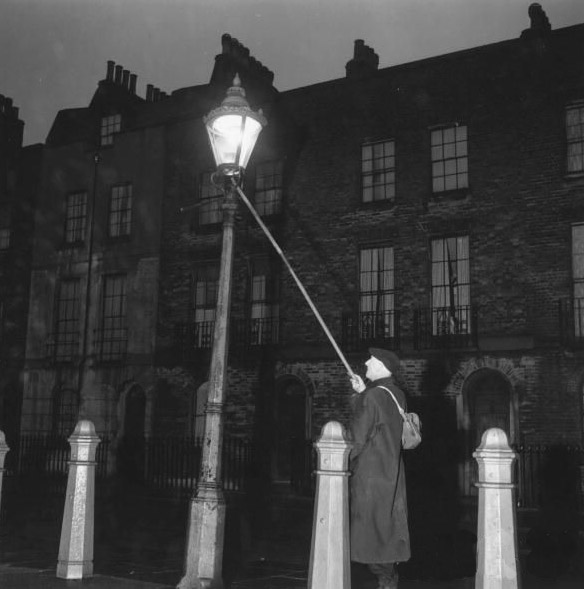
On one end of the terrace there were allotments with a street running parallel to it called Herd Street. I have a special reason to remember the street, for a man with a dancing bear came along it and I was too small to climb the little wall and get a safe distance from the approaching bear.

https://commons.wikimedia.org/wiki
For a small child, the sight of a bear, perhaps seven foot tall, must have been terrifying. Typically, these bears performed to entertain crowds at fairs until the practice was eventually outlawed.
The taste of raw potatoes when young and seeing my father kill a fowl at the allotments is fresh in my mind. A tall wall ran parallel with the Terrace in the front and belonged to the back garden of the public house called “The “Alley Sloper”.
With many working class people living in cramped housing in towns with little land for a garden, public allotments were an important provision, as they allowed people to grow their own food. Many also kept chickens for eggs and for the dinner table.
I did a little research to see if I could find some information on “The Alley Sloper”. I couldn’t find any reference to a public house called “The Alley Sloper” in Marlborough, but I did discover that “Alley Sloper” was a popular cartoon character at the time. This lazy wastrel was often found sloping around in alley ways, avoiding his creditors, and first appeared in the humorous comic magazine “Judy” in 1867, a rival magazine to “Punch”. The character was so popular that in 1884 he had his own comic, “Alley Sloper’s Half Holiday”, and his image was used for all sorts of merchandise. Here is one of the cartoons:
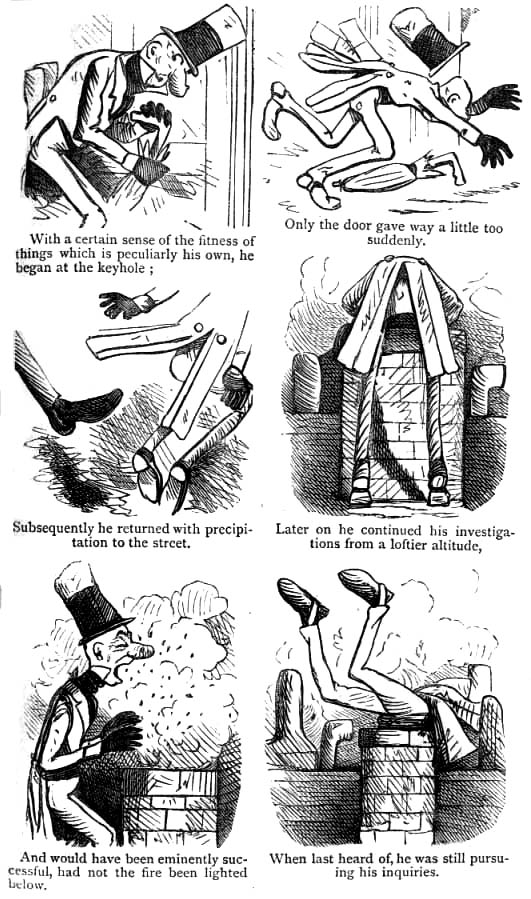
I did discover that there was a public house called “The Cricketers Inn”, very close to Kingsbury Terrace on Kingsbury Street in Marlborough. This was a restaurant until recently but is now a private house:
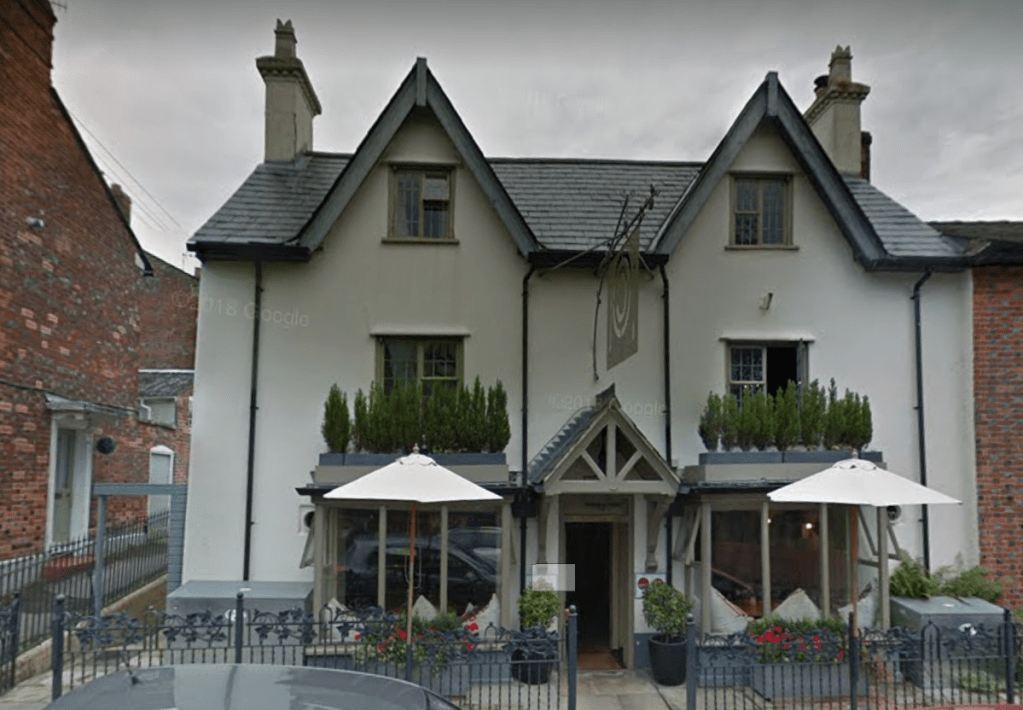
Image – Google Maps 2016 – https://www.google.co.uk/maps
I decided to check street directories and found a street directory for Marlborough, published in 1899. At 27 Kingsbury Street is “The Cricketers’ Inn” run by none other than “Mrs Sloper! “The Alley Sloper” was probably its nickname:
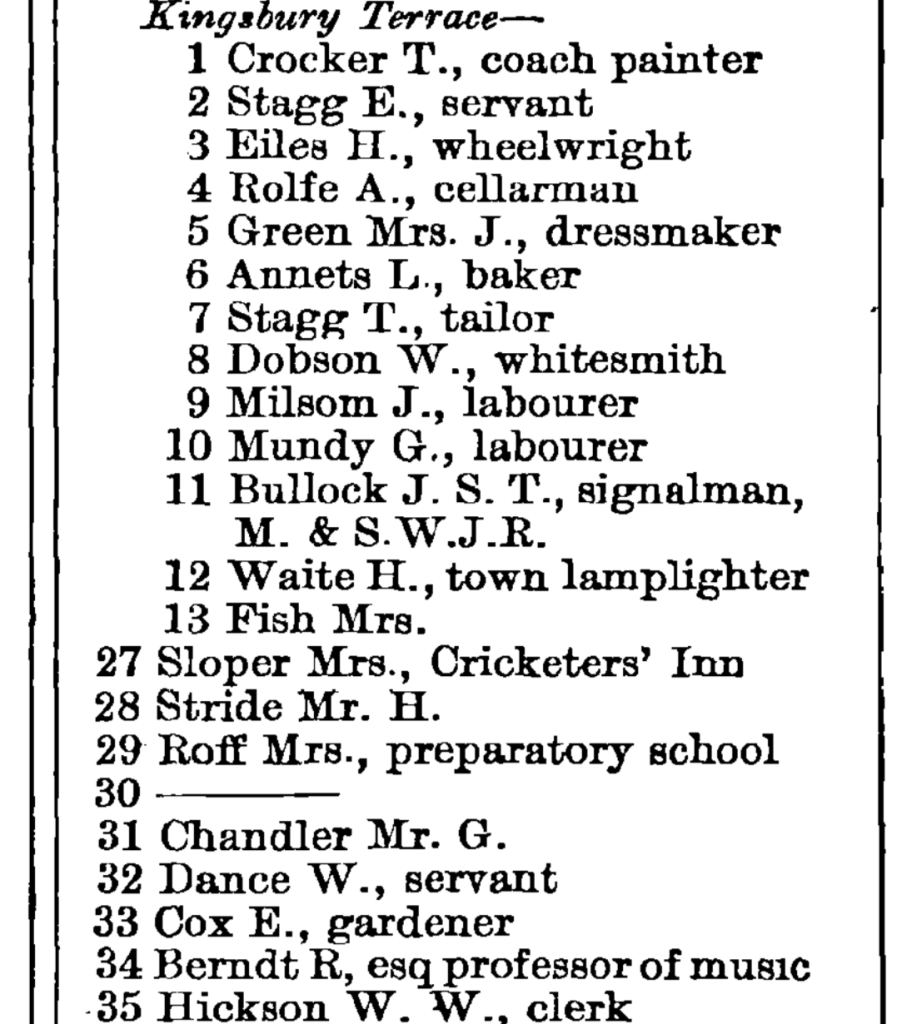
It is really interesting to see the inhabitants of Kingsbury Terrace and their various occupations. Granddad’s father, Josiah Simeon Thomas Bullock, a signalman with the M & S.W.J.R. [Midland and South Western Junction Railway], is listed at No. 11 Kingsbury Terrace.
Josiah Simeon Thomas Bullock worked as a signalman at nearby Savernake. Savernake was a busy junction situated to the south-east of the town. It has a complicated history because of the many small railway companies that competed for the rights to run lines in the area. The Berks and Hants Railway opened in 1862, and ran from Hungerford to Devizes with a station at Savernake. Two years later, the Marlborough Railway opened a small branch line from Savernake to the station at Marlborough, which was run by the Great Western Railway, so Savernake formed a junction. The Midland and South Western Junction Railway meanwhile built a line to connect Cheltenham with Southampton, and had their own stations at both Marlborough and Savernake, much to the annoyance of their rivals, the Great Western Railway.

My father was a signalman on the old M. & S.W.J.R. the station being right out of the town near Savernake Forest. He must have been waiting for the railway cottages to be built as we moved there shortly afterwards. The empty horse-boxes in the sidings were a great attraction to us children. I was missing one night and was found after a search in a horse-box, the door handle had been too stiff for me to open the door.
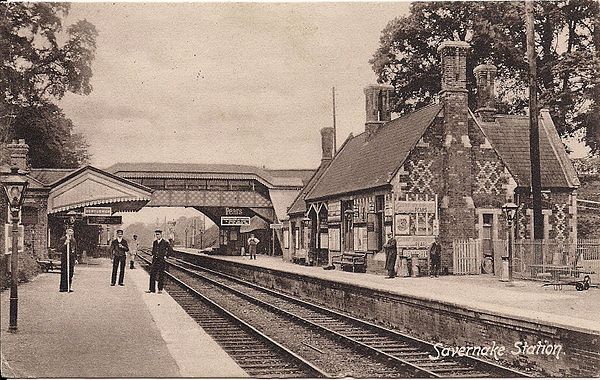
https://commons.wikimedia.org/wiki/File:
Savernake_Low_Level_Station.jpg
It’s interesting that according to Granddad, the family moved from Kingsbury Terrace to a railway cottage at Savernake. James Rees, Ernest’s younger brother, was baptised in the church of St Mary the Virgin, Marlborough in May 1895, as was his younger sister, Constance in May 1898, and on both occasions, the family’s address in the register was Kingsbury Terrace. Perhaps the move occurred after May 1898. Certainly the family had left the area when the 1901 census was taken.
Although Josiah Bullock would have received a regular wage, it was still a struggle for many workers to feed their family, even if habits were temperate and they grew their own produce on an allotment. Wages were meagre and when rent had been paid, there probably was not much left over. Unfortunately, I do not have Josiah’s railway employment records for this period, (the M. & S.W.J. Railway records are held by the National Archives and have not been digitised), but his brother, Ernest Rees Bullock, who also worked as a signalman, earned between 23 and 24 shillings a week at this time when he worked for the Great Western Railway.
Food must have been very short in those days for I remember going to the local university or college and asking for two-penny worth of pudding, the leftovers from the college lunch, and having a taste on the way home.
The “university” or “college” is of course, Marlborough College, which is in the centre of the town. Perhaps little Ernest, accompanied by his elder sister, Amy, and elder brother, Josiah, went together to the school kitchen, to see what they could get to take home.

Also the visits to the soup kitchen where the Town Crier in his resplendent uniform, served the food with a long-handled ladle and rapped those, who made too much noise, on their boater hats which were worn in those days.
The office of Town Crier is still in existence in Marlborough today. The Town Crier opens the annual “Mop” Fair and exercises his ancient right to test the quality of the beer served in local hostelries. I found a postcard of the Town Crier of Marlborough in 1900, probably the very same man that Granddad remembered. This shows him to be a portly fellow, dressed in a long jacket with a velvet trim, shiny buttons and a top hat. He carries a bell in his hand in order to call attention. You can imagine what an imposing figure he cut to a small child:
https://www.alamy.com/marlborough-town-crier-c1900-image352525305.html
This was the time of the Boer War and we children had a good time with the soldiers on their way to the front, who gave us chocolates and nuts. Their favourite tune was the popular “Goodbye Dolly I must leave you”, and my father would sing as he dangled one of us on his knee the same refrain.
“Goodbye Dolly” was an American music hall song, originally composed in 1897 and popular in America during the Spanish-American War of 1898. It subsequently became a popular tune in the Boer War, and was also sung by soldiers going off to fight in the First World War. I love the picture Granddad paints of an affectionate father, singing the catchy song whilst playing with his small child on his knee.
The Boer War broke out in October 1899 and the railways played an important role in transporting troops and their equipment to and from Salisbury Plain in southern Wiltshire, where their training took place. You can just imagine the generous soldiers singing and leaning out of the windows of the train, sharing treats from their rations with the local children who were waving to them.
Goodbye Dolly Gray I have come to say goodbye, Dolly Gray, It's no use to ask me why, Dolly Gray, There's a murmur in the air, you can hear it everywhere, It's the time to do and dare, Dolly Gray. So if you hear the sound of feet, Dolly Gray, Sounding through the village street, Dolly Gray, It's the tramp of soldiers' true in their uniforms so blue, I must say goodbye to you, Dolly Gray. Goodbye Dolly I must leave you, though it breaks my heart to go, Something tells me I am needed at the front to fight the foe, See - the boys in blue are marching and I can no longer stay, Hark - I hear the bugle calling, goodbye Dolly Gray.
A new century dawned and ushered in the death of Queen Victoria in January 1901. Ernest and his family said goodbye to Marlborough, as they started a new chapter in their lives in Wantage, Berkshire. In my next blog, A Berkshire Boyhood, I will be looking at Ernest’s memories of growing up in Wantage during the Edwardian period.
Conclusion
I consider myself to be immensely fortunate to have my Granddad’s written account of his childhood though sadly, I have no photograph of him as a child. Perhaps you only possess family stories, maybe some letters, or your own personal memories of your grandparents. Nevertheless, these can form a nucleus around which you can explore both the local history of where they lived and the social history of their time. With some additional research, I have certainly gained a much better appreciation of my Granddad’s childhood. I would like to encourage you to similarly use the information that has been passed down to you about your own family members to expand your knowledge of their lives and times. You will also produce something that your family can appreciate and enjoy.
© Judith Batchelor 2020
Hi Jude, a fascinating insight into the young life of your grandfather and the lovely town of Marlborough, thank you.
I went to a boarding school in Cheltenham in the 1970’s, we lived in Southampton, my father always drove up via the Savernake Forest, Marlborough and Swindon. I was not aware of the M&SWJ Railway although it had closed by then. My father, uncle and Grandfather all went to the same school in Cheltenham in 1940’s and 1900’s, they lived in Winchester. I am now thinking they may have travelled there using the M&SWJ line.
Phil,
LikeLiked by 1 person
I think that is very likely that they travelled, at least part of the way, with the M & SWJ Railway.
The history of the railway companies in this area is interesting. The purpose of the M & SWJ Railway was to link the Midlands with the port of Southampton so it ran north to south. Inevitably it had to cross other railway company lines that were journeying from east to west. I think there was a lot of conflict with competing interests, engineering problems and lack of money.
LikeLike
What a wonderful story Jude, a real trip down memory lane! How lovely that you have Grandad’s words, written in his own hand, so lucky. I am looking forward to hearing more of Grandad’s exploits in future episodes.
LikeLiked by 1 person
Thank you! His naval stories are fantastic too. It’s great to have his first-hand experiences.
LikeLiked by 1 person
Im sure he had a story or three about his Naval exploits, not for the feint hearted I’m sure!
LikeLiked by 1 person
What a wonderful peek into your family history from your grandfather’s memories. Being born in California, I often wonder what life was like in Hilperton for my 2nd great-grandparents James and Hannah (Rich) Richman in the 1820-1850 time frame. They came to America in 1855 and settled in New England. While this article is about a different time, it is still fascinating because so much has changed between then and now.
LikeLike
Thank you! It does give you a glimpse of how life was like at the time. I love all the small details. Have you ever read “Kilvert’s Diary”? Reverend Kilvert was born in Langley Burrell, Wiltshire but wrote a diary between 1870-1879 when a curate in Herefordshire, which conjures up Victorian country life.
LikeLike
Thank you, Jude. I enjoyed this glimpse into your grandad’s young life and look forward to more. I appreciate your encouragement for us to do similar research into our own family stories and you’ve provided an excellent example, which I plan to follow for my own grandad’s account.
LikeLiked by 1 person
Thank you! It’s a great thing to do, as the whole family appreciate it. My granddad died when I was little and I feel I know him a bit better now.
LikeLike
Thank you again for such an interesting story with wonderful photos. You have inspired me to explore more of the social history in my family trees. My husband’s family had left Wiltshire by the 1890’s for Wantage area in Berkshire, so really looking forward to more of your Granddad’s tale. I don’t suppose you go on to Gloucestershire and Sussex?!
LikeLiked by 1 person
Thank you Lynn! I am a big fan of exploring the social history, as it helps to give a flavour of the times and adds a lot of interest to the family history. What a coincidence that your husband’s family also moved to Wantage from Wiltshire! I’m afraid my family stayed put there, though Granddad left to see the world in the Royal Navy.
LikeLike
This is of especial interest to me as it opens so much of a past Marlborough now sadly hidden and marginalised. The material about the lamplighter reminds me of an interview with Isobel Webb (sadly now deceased) who remembered the lighting of the lamps. I was inspired to write an essay for my Public History MA called “Marlborough By Gaslight”. Since then I have adapted this to produce a talk of the same name which can be found on my website http://www.wiltshirehistoryman.org.uk The fascinating connections with the Midland South Western Junction Railway are seminal to Marlborough’s railway past. Thank you Jude for this. I have enjoyed reading this more than anything else I can think of for quite some time!
LikeLiked by 1 person
Thank you, I am glad it struck some chords with you. I will certainly take a look at your talk.
LikeLike
Really lovely that you have his memoirs and can read them and add further context to them with the information you can find out now. I lived in Marlborough from 1987 to 2001, grew up and went to school there. I love the town and it is nice to read about the places I’m familiar with.
LikeLiked by 1 person
Glad you enjoyed reading about Marlborough in times past. I have visited, but many years ago. I would love to have a long walk around the town, seeing all the sights.
LikeLiked by 1 person